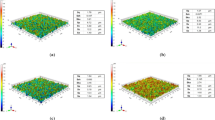Abstract
Appropriate selection of welding conditions to guarantee requisite weld joint mechanical properties is ever difficult because of their complex interactions. An approach is presented here to identify suitable welding conditions in typical two-wire tandem submerged arc welding (SAW-T) that involves many welding variables. First, an objective function is defined, which depicts the squared error between the mechanical properties of weld joint and of base material. A set of artificial neural network (ANN)-based models are developed next to estimate the weld joint properties as function of welding conditions using experimentally measured results. The neural network model-based predictions are used next to create a set of process map contours that depict the minimum achievable values of the objective function and the corresponding welding conditions. In typical SAW-T of HSLA steel, welding speed from 9.0 to 11.5 mm/s, leading wire current from 530 to 580 A, and trailing wire negative current from 680 to 910 A are found to be the most optimal.





Similar content being viewed by others
References
G. Almqvist, I. Gronbeck, S.B. Jones, and D.E.H. Reynolds, Submerged Arc Welding, 2nd ed., The Welding Institute, Cambridge, 1978
G.D. Uttrachi, Multiple Electrode Systems for Submerged Arc Welding, Weld. J., 1978, 78(5), p 15–22 (in English)
Waveform controlled technology power wave AC/DC submerged arc, http://www.lincolnelectric.com/assets/en_US/Products/literature/NX230.pdf. Accessed 10 July 2012
P.J. Konkol and G.F. Koons, Optimization of Parameters for Two Wire DC-AC Submerged Arc Welding, Weld. J., 1978, 78(12), p 367s–374s (in English)
A. Pilipenko, “Computer Simulation of Residual Stress and Distortion of Thick Plates in Multi-Electrode Submerged Arc Welding and Their Mitigation Techniques,” Ph.D. Thesis, Norwegian University of Science and Technology, 2001
H. Farhat, “Effects of Multiple Wires and Welding Speed on the Microstructures and Properties of Submerged Arc Welded X80 Steel”, M.S. Thesis, University of Saskatchewan, 2007
D.M. Viano, N.U. Ahmed, and G.U. Schumann, Influence of Heat Input and Travel Speed on Microstructure and Mechanical Properties of Double Tandem Submerged Arc High Strength Low Alloy Steel Weldments, Sci. Technol. Weld. Join., 2000, 5(1), p 26–34 (in English)
S. Moeinifar, A.H. Kokabi, and H.R.M. Hosseini, Role of Tandem Submerged Arc Welding Thermal Cycles on Properties of the Heat Affected Zone in X80 Microalloyed Pipe Line Steel, J. Mater. Process. Technol., 2011, 211(9), p 368–375 (in English)
D.V. Kiran, B. Basu, A.K. Shah, S. Mishra, and A. De, Probing Influence of Welding Current on Weld Quality in Two Wire Tandem Submerged Arc Welding of HSLA Steel, Sci. Technol. Weld. Join., 2010, 15(2), p 111–116 (in English)
D.V. Kiran, B. Basu, and A. De, Influence of Process Variables on Weld Bead Quality in Two Wire Tandem Submerged Arc Welding of HSLA Steel, J. Mater. Process. Technol., 2012, 212(10), p 2041–2050 (in English)
S. Pal, S.K. Pal, and A.K. Samantaray, Artificial Neural Network Modeling of Weld Joint Strength Prediction of a Pulsed Metal Inert Gas Welding Process Using Arc Signals, J. Mater. Process. Technol., 2008, 202(1–3), p 464–474 (in English)
A.K. Lakshminarayanan and V. Balasubramanian, Comparison of RSM with ANN in Predicting Tensile Strength of Friction Stir Welded AA7039 Aluminum Alloy Joints, Trans. Nonferr. Met. Soc. China, 2009, 19(1), p 9–18 (in English)
V. Gunaraj and N. Murugan, Prediction and Comparison of the Area of the Heat Affected Zone for the Bead on Plate and Bead on Joint in Submerged Arc Welding of Pipes, J. Mater. Process. Technol., 1999, 95(1), p 246–261 (in English)
S.H. Lalam, H.K.D.H. Bhadeshia, and D.J.C. MacKay, Estimation of Mechanical Properties of Ferritic Steel Welds. Part 2: Elongation and Charpy Toughness, Sci. Technol. Weld. Join., 2000, 5(3), p 149–160 (in English)
D.C. Montgomery, Design and Analysis of Experiments, 5th ed., John Wiley & Sons, New York, 2001
“Standard Test Methods for Tension Testing of Metallic Materials”, E8M, Annual Book of ASTM Standards, ASTM, 2001
S. Haykin, Neural Networks: A Comprehensive Foundation, 2nd ed., Prentice-Hall International, New York, 1999
J.M. Zurada, Introduction to Artificial Neural System, 1st ed., Jaico Publishing House, Mumbai, 1994
Acknowledgments
The authors gratefully acknowledge the financial support provided by the Government of India (grant no. NMRL/PP&C/1207/MISC) to carry out the present research study.
Author information
Authors and Affiliations
Corresponding author
Rights and permissions
About this article
Cite this article
Kiran, D.V., Alam, S.A. & De, A. Development of Process Maps in Two-Wire Tandem Submerged Arc Welding Process of HSLA Steel. J. of Materi Eng and Perform 22, 988–994 (2013). https://doi.org/10.1007/s11665-012-0381-2
Received:
Revised:
Published:
Issue Date:
DOI: https://doi.org/10.1007/s11665-012-0381-2




